In 1932, Bradbury was captivated by the performance of Mr. Electrico, a carnival magician. At the end of the act, Electrico reached out to the twelve-year-old Bradbury and commanded, “Live Forever!” Bradbury later said, ”I decided that was the greatest idea I had ever heard. I started writing every day. I never stopped.” Read below to see how Bradbury lives forever through the people he continues to inspire.
Featured Artist: Rephun Menachem
September 6, 2021
Like so many readers, Menachem Rephun discovered Ray Bradbury’s Fahrenheit 451 in middle school and was hooked by the author’s vibrant imagination and poetic prose. Rephun continued to explore the Bradbury canon and “became an ardent fan.” Reading was an education in itself but he also went on to study literature and creative writing at Fairleigh Dickinson University. In Rephun’s former work as a journalist, he often focused on human stories that hit close to home—a beloved rabbi’s eulogy on bitachon and the death of a community elder, the struggles of a neighborhood foodbank.
An eclectic reader, Rephum shows an appreciation of the dark, winding, and often exhilarating metaphorical ravines that shape our individual and collective lives. As a writer and editor, he continues to explore how the lessons woven through Bradbury’s works are reflected in current events. His recent article, “A Pleasure to Burn: Revisiting Fahrenheit 451 in an Age of Uncertainty” continues a series of meditations on an unusual reading list that seems inspired not only by the pandemic, but by the mix of fantasy, horror, and mystery Rephun discovered early with Ray Bradbury: Franz Kafka’s The Trial, Cormac McCarthy’s Blood Meridian, William Golding’s The Inheritors, and Mikhail Bulgakov’s gem, The Master and Margarita.
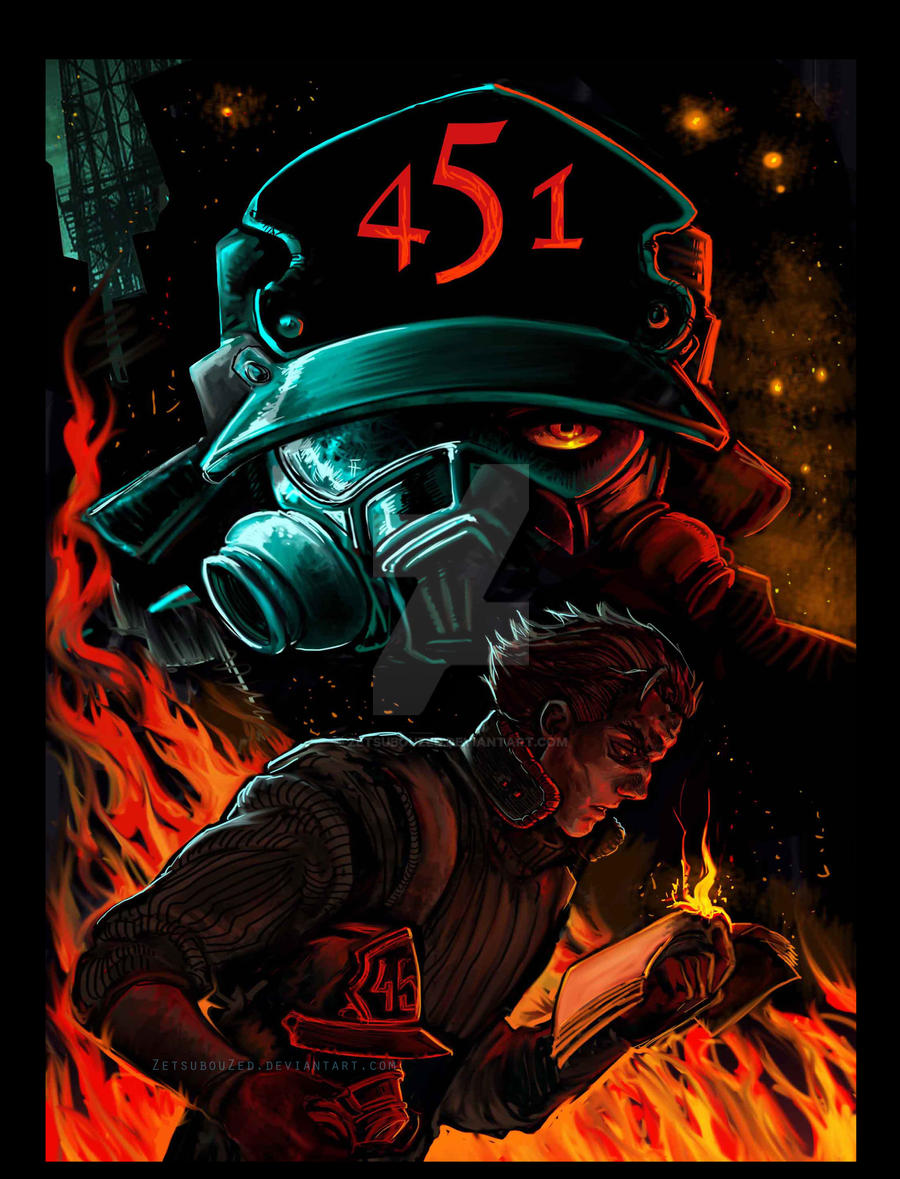
It is worth reading the meditations “A Pleasure to Burn: Revisiting Fahrenheit 451” and “Bulgakov: When the Devil Comes to Town” together to see Rephun’s overarching message. As in Fahrenheit 451, the public in The Master and Margarita are not awakened to the dangers of evil, but cynically or unthinkingly focus on their own day to day comforts and self-interest. In a real-life twist worthy of a Bradbury plot, Bulgakov burnt his earliest manuscript himself in 1930, convinced that it could not be published in a climate of thought control. He later returned to what is now considered a masterpiece on the dangers of oppression but even the heavily censored version was suppressed for decades, like the books the fireman Montag incinerates. The complete novel was finally published posthumously in Paris in 1967, by editors who painstakingly knit together the dissident’s manuscripts with expurgated Soviet versions and privately published samizdat—the clandestine self-publishing that echoes the methods and origins of Bradbury’s book people.
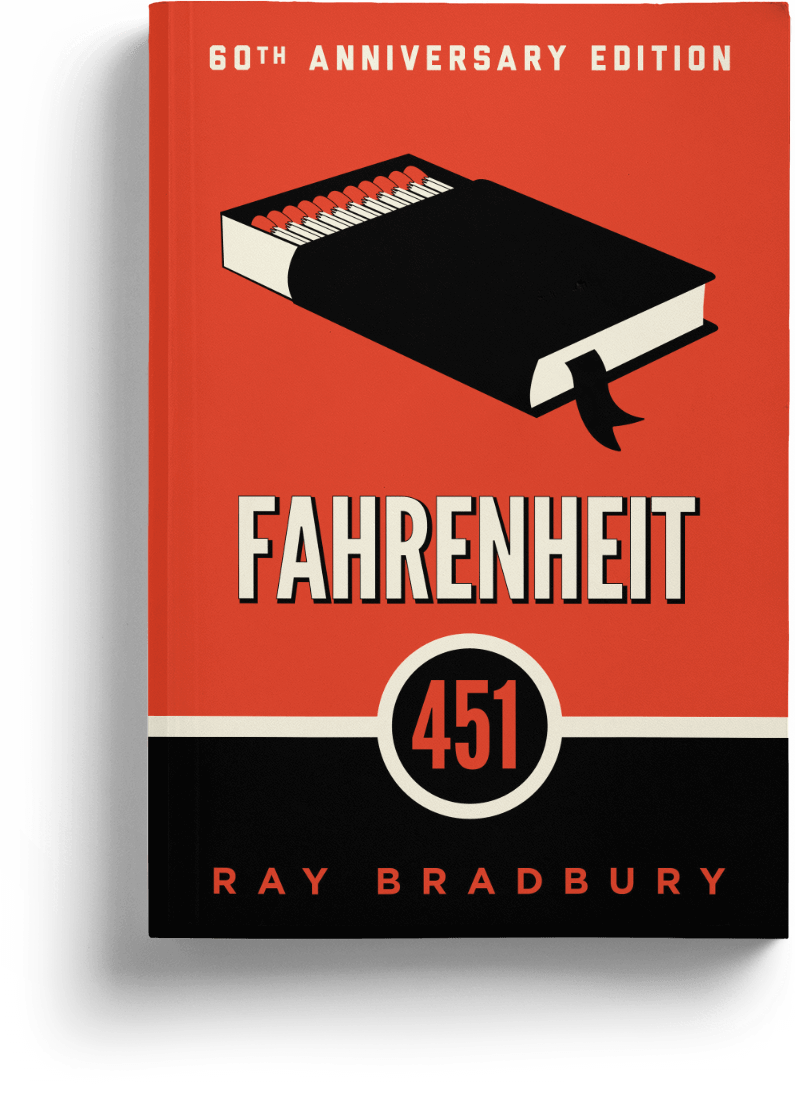
In his blog Meditations in an Emergency Rephun shows us how the love of reading and belief in the power of language he discovered through Bradbury continues to shape his outlook. He sets the opening line of Fahrenheit 451, “It was a pleasure to burn,” against the warning Bulgakov’s Devil gives an author who tries to burn his own manuscript, “Manuscripts don’t burn.” That desire for destruction, for burning, Menachem Rephun suggests, is thwarted by the inability to destroy stories that live in the human heart and mind as Ray Bradbury’s stories have lived in his.
Rephun’s writing is animated by the desire to share these good stories with others and remind them of the hopeful and timely message he finds in Fahrenheit 451: “If we can, against all odds, preserve our intellectual curiosity, our decency, our compassion and care for one another, maybe, just maybe…there will be some hope for us in the end.”
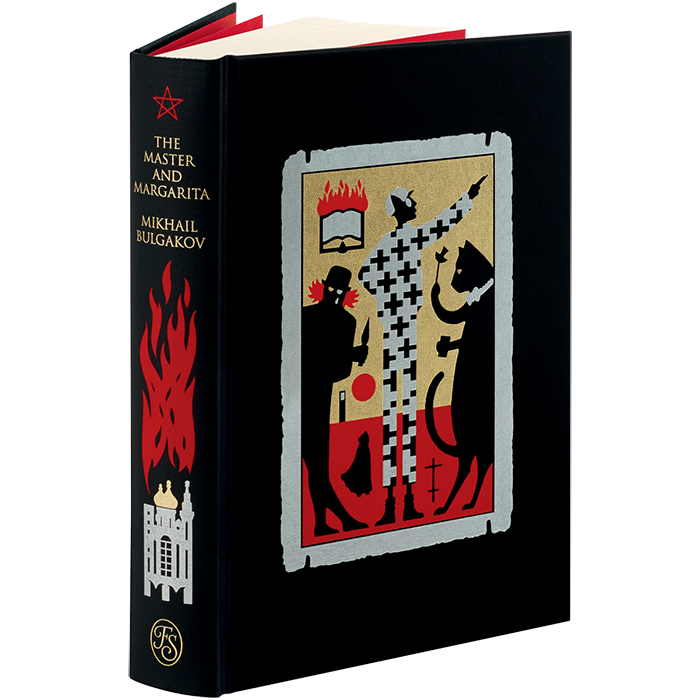
Menachem Rephun lives and writes from New York. His journalism has appeared online in various places, including the Jerusalem Press, the Jewish Voice, and Film Criticism, the third oldest academic film journal in the United States. You can read his recent articles and poetry on his blog, Meditations in an Emergency. His novel This Could Be the Day is available in paperback and on Kindle.
Read “A Pleasure to Burn: Revisiting Fahrenheit 451 in an Age of Uncertainty”
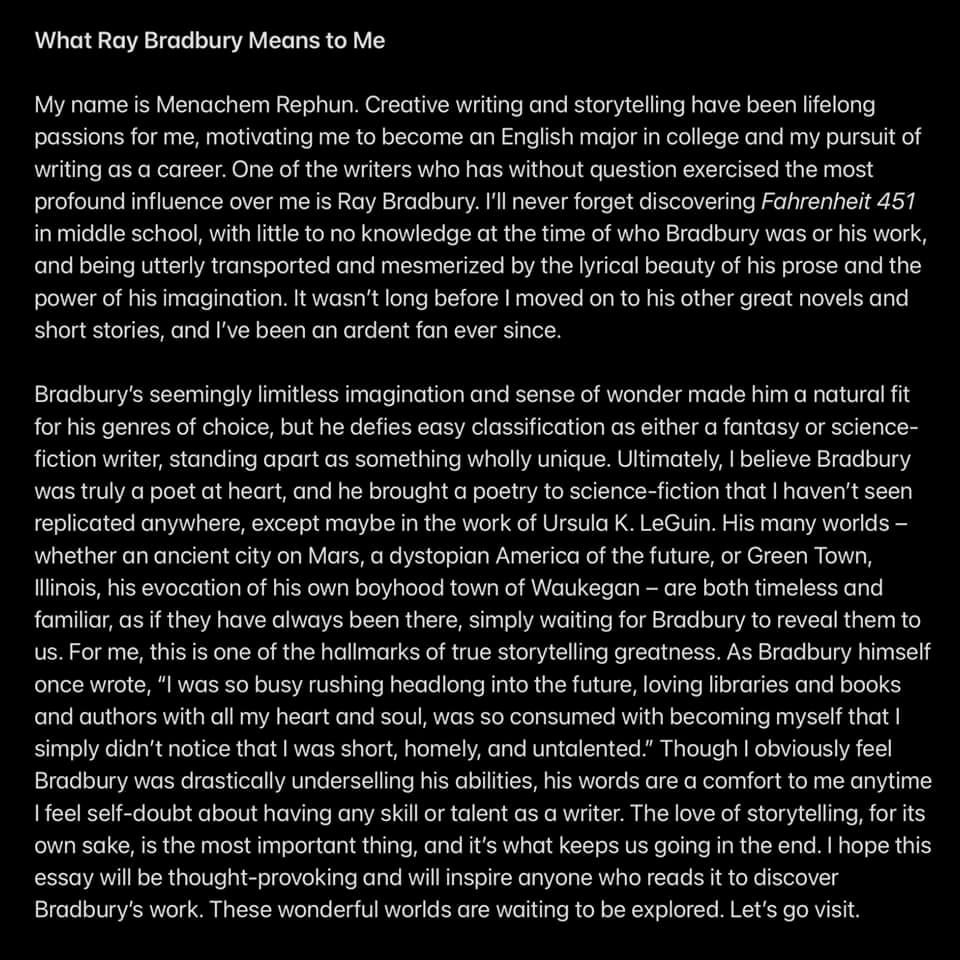
Featured Artist: John Randall York
March 27, 2021
John Randall York, an American artist, designer, illustrator, cartoonist, watercolorist, and musician, loves to bring the whimsical places and creatures of imagination—and memory—to life. Known for capturing the unseen world of fairies, witches, dragons, and spirits in lush watercolors, his popular jack-o’-lantern filled Halloween tree prints evoke both the joy and the foreboding that Ray Bradbury captured in his perennial favorite, The Halloween Tree.
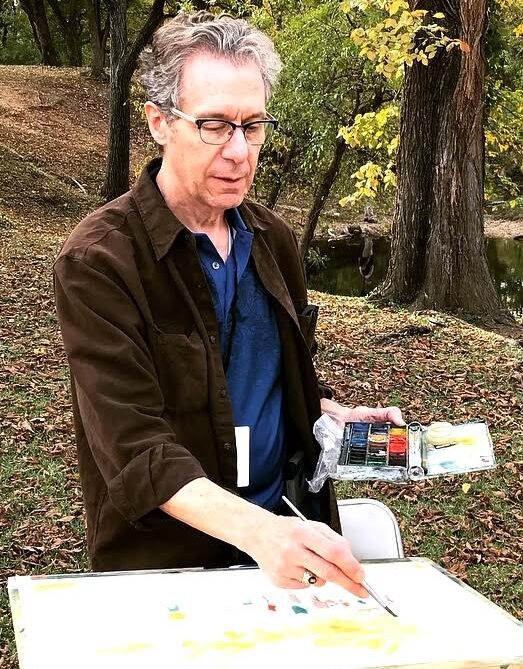
York was born in Tyler, Texas, where he has lived most of his life. He met his wife at John Tyler High School, attended Tyler Community College, and graduated with a BFA from the University of Texas at Tyler. Family roots in the area run deep. His parents met downtown on Tyler’s square and his grandfather, Henry York, lived in nearby Garden Valley where he produced postcards and prints of the scenes he captured as he travelled throughout eastern Texas in a horse and buggy loaded with his photographic equipment. An extensive collection of those prints in the local Historical Society brings the world of early 20th century Smith County to life.
 "The Liberty Theater" by John Randall York
"The Liberty Theater" by John Randall York
John York, however, was drawn to recreating the fantastic landscapes of his mind’s eye as he worked in his studio. Then, in 2016, he took to carrying his sketch pad and watercolors around Tyler to capture the people and places of his own time and place. Although he continues to explore other-worldly themes, the more realistic watercolors of present-day Tyler are animated by a sense of local memory and preservation. They capture the Texas town just as Ray Bradbury’s Dandelion Wine or Something Wicked This Way Comes captured Waukegan, Illinois. Whatever the future might bring, places like the old boarding house a quarter mile from where York was born or the downtown Liberty Theater, where moviegoers can queue up beneath an old fashioned marquee, are now preserved in timeless watercolors, as are the places like the Alamo that catch York’s eye when he travels.
York discovered Ray Bradbury in junior high when he read “The Pedestrian.” He immediately felt the connection between what Bradbury did with words and his own visual art. “His words were like brilliant paint,” Tyler said. ”I felt like I was there with the character. Often the most powerful pigments in my studio can be found in From the Dust Returned, Something Wicked This Way Comes and, of course, The Halloween Tree.” After The Halloween Tree was adapted for the screen, York watched it every year. Paintings of pumpkin heads and ancient trees grace the walls of his home: the shared love of the holiday is a continued link to Bradbury. As York sees it, “Ray Bradbury IS Halloween! Halloween IS Ray Bradbury!”
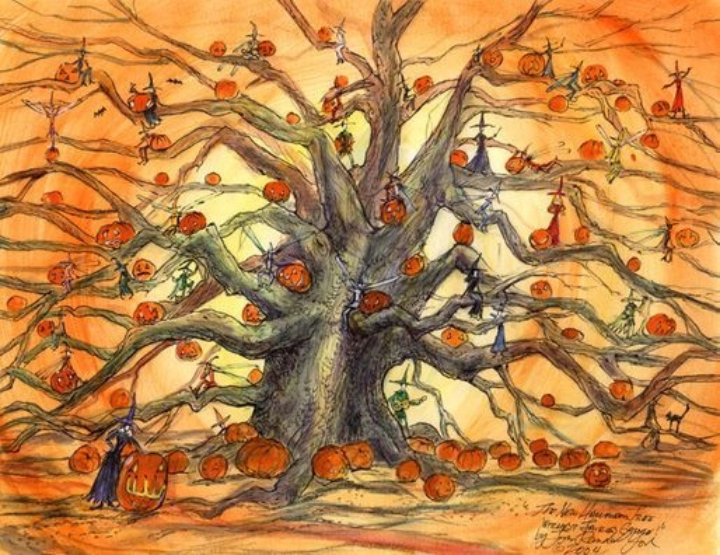 "New Halloween Tree" by John Randall York
"New Halloween Tree" by John Randall York
For York, art is often about first impressions and capturing a moment. He works quickly and doesn’t always know exactly what he is going to draw, he says, until the drawing is done. As York explained, “I try to follow Ray’s advice: ‘Don’t think. Thinking is the enemy of creativity. It’s self-conscious and anything self-conscious is lousy. You can’t try to do things. You simply must do things.’ When I do my best work it is when I have followed that advice. My quest is to discover what’s inside, to see what I’m made of, and I’m very happy when other people enjoy that in my work.”
Fantasy and horror author Greg Miller was among those who enjoyed the energy in York’s extensive Halloween and fantasy themed art. Miller felt he had found a kindred spirit who could translate his own stories, a mix of bittersweet nostalgia and inescapable horror, into color and line. Both men had been inspired by Bradbury’s writing and philosophy. York now illustrates Miller’s books, including the popular Crows at Twilight and The Uncanny Valley: Tales from a Lost Town.
The quest to “simply do things,” as Bradbury suggests, has led John York to explore and conquer a variety of mediums. He composes and performs his own music and pens comics like “The World’s Greatest Dinosaur Knight” for the young and young at heart.
His designs have been sold through Neiman-Marcus, Gump’s, Nordstrom, Bloomingdales, Walt Disney World, and Jefferson’s Monticello Collection. Five of his detailed porcelain boxes were featured in Keith and Thomas Waterbrook-Clyde’s The Decorative Art of Limoges Porcelain and Boxes.
Visit York’s collection online
Visit York’s Website
Watch York’s YouTube channel
York Prints at Fine Art America
York’s Facebook: https://www.facebook.com/pg/JohnRandallYork
York’s Twitter: https://twitter.com/johnrandallyork
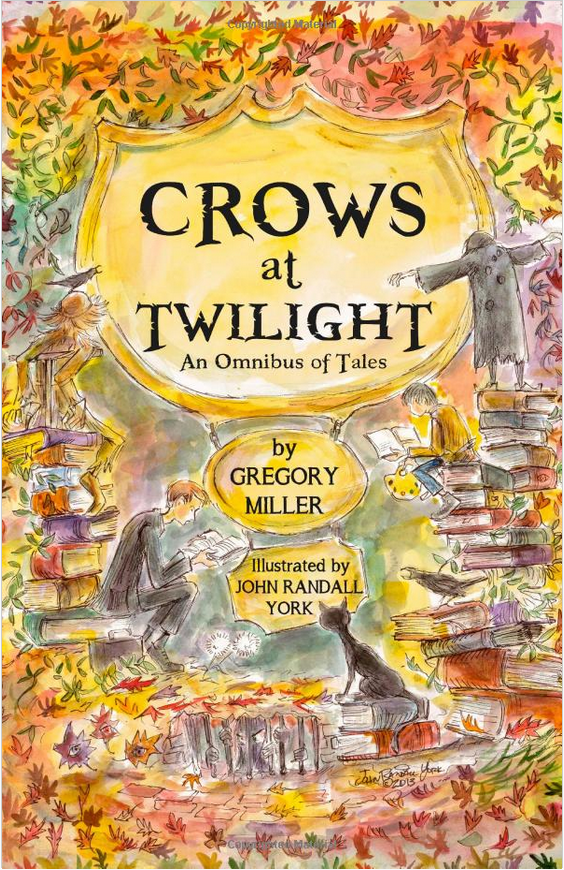 Crows at Twlight by Gregory Miller
Crows at Twlight by Gregory Miller
Featured Artist: Ron Koertge
Janaury 30, 2021
Award winning South Pasadena Poet Laureate Ron Koertge recently penned a poem to accompany the stained glass window installation in the Bradbury meeting room of the South Pasadena Public Library. Koertge’s acquaintance with Bradbury, however, began some forty years ago: he and Bradbury frequented the same writer’s conferences and the famous author was a regular at South Pasadena Library events. Koertge and others often joined Bradbury afterwards for coffee. With “In Memoriam,” Koertge sets Bradbury’s desire to “live forever” through his work against the advice the author once offered at one of those sessions: “Mess around after you get your work done.”
Koertge, styled by United States Poet Laureate Billy Collins as “the wisest, most entertaining wiseguy in American poetry” has always been good at “messing around” as part of his work. He was not truly drawn to poetry until the legendary Southern California poet Gerry Locklin introduced him to the world of small poetry magazines where quirky and accessible, Koertge’s preferred style, flourished. Known not only for poetry but for acclaimed young adult novels, his sardonic wit and willingness to challenge authority and convention continue to draw an audience that values honesty and delights in irreverent fun. Not unlike Bradbury himself, Koertge threw off the idea of writing to impress academics early on. He continued to write young adult novels that rang true because, as his friend author Merrill Joan Gerber once told him, he is “chronically immature.”
 Image: dtv
Image: dtv
That attachment to his inner child has not interfered with developing a thorough knowledge of classic poetic forms and a keen ear for the sounds and rhythm of language. Koertge, who had taught all manner of literature and composition classes during his 35 year career at Pasadena City College and Hamline University’s low-residency MFA program, follows the advice he recalls Bradbury passing on: “Put your butt in the chair. Write something.” On days when a poem doesn’t spring to mind, he works on something formulaic–a sonnet, a sestina, a haiku–because he believes, as Bradbury did, that writers should write something every day to hone their craft.
That practice laid the foundation for several novels written in verse. The Brimstone Journals lays out its plot in a selection of poems from 15 teenage characters. Shakespeare Bats Cleanup and Shakespeare Makes the Playoffs tell their story through a series of poems in almost every imaginable form, making them a favorite of English teachers. His latest book of poetry is Yellow Moving Van.
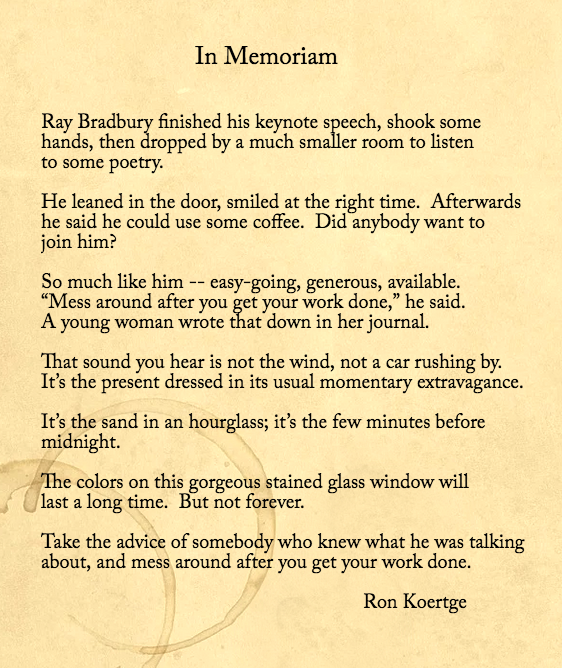
December’s Featured Artist: Esteban Cánepa
December 3, 2020
Esteban Cánepa will always remember how his father lent him just the right stories from the never-ending bookshelves that filled their home in Argentina. The elder Cánepa handed down a love of literature to his son, but it was the son who introduced the father to a genre the boy had discovered on his own: science fiction. Estaban recommended The Martian Chronicles and his father loved it.
Today, Cánepa is a professional illustrator, storyboard and concept artist for advertising and cinema, and human rights activist. He has also taught Image & Sound Design at the University of Buenos Aires, his alma mater. The poetry and humanism of Ray Bradbury continues to fascinate and inspire him.
In a work of art based on The Martian Chronicles, “The Fog Horn,” Fahrenheit 451, and others, Cánepa celebrates the timeless appeal of Bradbury’s exploration of love, curiosity and the human desire to reveal the unknown. In evocative illustrations sometimes reminiscent of the work of Ray Bradbury’s friend and collaborator artist Harry Harryhausen, the Argentine artist renders Bradbury’s mythic words and worlds in pen and ink. Cánepa fittingly points to a quote from Fahrenheit 451 to explain Bradbuy’s continuing influence on him and others around the globe: “Grandfather’s been dead all these years, but if you lifted my skull, by God, in the convolutions of my brain you’d find the big ridges of his thumbprint.”
 artwork by Esteban Cánepa
artwork by Esteban Cánepa
Cánepa, like Bradbury himself, is not content to share his own passions for science, fiction, and science fiction in one form for one audience. In addition to his illustrations for books and comics, he has directed and written award winning short films, worked on designs for educational toys, and contributed his talents to social justice campaigns. He recently illustrated a University of Buenos Aires Faculty Press science book for young readers, sharing his love of science and visual art with a new generation.
 artwork by Esteban Cánepa
artwork by Esteban Cánepa